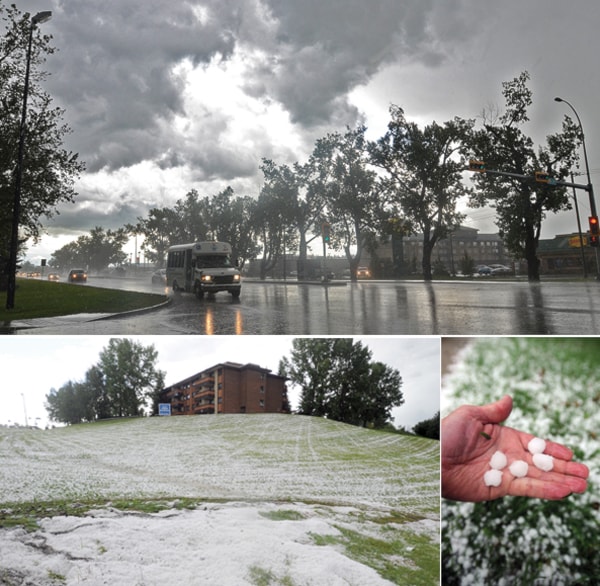Nasty weather is normal in July, say people who make their living with an eye on the sky.
Brad Romans, president of Ing and McKee Insurance in Red Deer, said insurance claims related to severe weather have been pretty much a given during the past 10 years.
It’s not like the whole region is under attack, but there have been isolated cases of severe damage every year, Romans said on Tuesday.
“I don’t like July and August. But (2011) hasn’t been worse than other years,” he said.
“If you’re an insurance person, we take lots of claims at this time of year. Have we taken as many claims this year as we have in some years? No, but we haven’t finished the year yet.”
Outside a few spots where fields were shredded in hail storms or laid flat under extreme downpours, most farmers in Central Alberta enjoyed ideal weather conditions during the past month, said Harry Brook, a field crop specialist with Alberta Agriculture and Rural Development’s Ag Info Centre in Stettler.
Unlike last July, which was uncharacteristically cool with day after day of drizzle, July of 2011 was sunny and bright much of the time, with good moisture conditions to start and plenty more rain to keep crops going between bouts of heat and sun, said Brook.
The jury is still out on whether cloud seeding has had an effect on limiting the damage from hail storms, he said. Some farmers in eastern regions of the province believe cloud seeding has squeezed the moisture out of the sky prematurely, so the storms have been wrung dry before they get to their part of the province.
With some isolated exceptions, July was normal overall in the Red Deer region, said metereologist Cindy Yu from the Environment Canada weather office in Vancouver.
Red Deer’s daytime highs averaged slightly below normal, although the overnight lows were slightly above normal for the month, indicating that cloud cover had prevented temperatures from dropping dramatically, said Yu.
She shows July 18 as the warmest day of the month, hitting a high of 27.6 with a thunderstorm marching in later in the day, producing 32 mm of rainfall.
Red Deer had averages highs of 20.3 this July, which is .6 degrees lower than its normal average of 20.9. Nighttime lows, on the other hand, were 9.2 compared to a July average of 8.8.
But Yu’s data paint a spotty picture of the extreme weather events that struck some parts of the region, including heavy rainfalls in Eckville and Lacombe on July 18 and 19 and again in Lacombe on July 26 as well as a series of hail storms that struck on Friday and again on Sunday, including reports of hailstones up to three centimetres across near Delburne on Sunday, said Yu.
Red Deer’s weather station reported 123.2 millimetres of moisture during the month, compared with an average of 92.2. Olds, on the other hand, reported only 48.2 mm while its July average is at 87 mm, she said.
While local observers reported rainfalls of 100 to 250 mm during the extreme storms on July 18, data from Environment Canada’s station at Lacombe show only 17.8 mm on the 18th and 47.4 mm on the 26th, said Yu.
The storms that wreaked the havoc appear to have been of a slow moving, highly localized nature with some of the results going undetected at the Environment Canada weather stations.
These seem to have been small, slow-moving cells in which there was heavy precipitation, but the effects were not widespread, so some actually missed the weather stations, she said. Yu did not have immediate access to reports from provincial weather stations, which may have the data to fill in the blanks.
There were no reports within the region of any tornadoes, although an RCMP office on patrol near Sundre counted a number of funnel clouds a few kilometres north of town, including one that came within 20 metres of the ground, said Yu.
Evening thunderstorms are common in July, building up during the heat of the day and letting loose as temperatures cool toward evening, she said.
The heaviest rainfall reported for Alberta during July was at Slave Lake, which received 201.9 mm during the month.
bkossowan@www.reddeeradvocate.com
